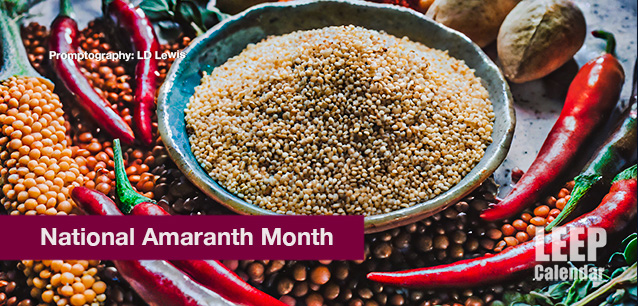 AD
AD
Today is: August 16
Scroll to explore events active on this date.
Additional Events on LEEP
LEEP INK FEATURES

August? Absolutely!
In August, we live through the Dog Days of Summer. It's hot and often humid, and those who can leave for better climates do. Down south, winter is in full force. August is also known as "the ...

In The Heat of July: July 2025 Events
Is it hot enough (or cold enough if you're below the equator) for you yet? There is actually a day for that! Like every month, I pick a diverse collection of events you may or may not know about. This ...

May Blooms: Events in May 2025
Along with October, May is one of the most densely packed months of the year. It's before the summer humidity and the last whole month of the school year. The weather is warming in t...
About Amaranth Month
Retail , United States
Ends: May 31, 2025
DESCRIPTION:
May is Amaranth Month. Amaranth is a grain revered for its nutrient-rich profile and versatility. Though tiny, amaranth is a mighty grain easily distinguished by its vibrant colors ranging from gold to red. It was a staple food of the native tribes of Central America for centuries, culminating in Mexico's Aztec Empire. Its colorful composition rendered it an integral part of Aztec religious ceremonies, leading to its banning by Spanish conquistadors despite its nutritional value. The grain survived in rural isolation high in Mexico and the South American Andes mountainous regions. It would remain primarily hidden and unknown until the late twentieth century.
Beloved for its slightly nutty and earthy flavor, amaranth is often cooked like rice, added to soups, or used to make porridge. It's also ground into flour for baking, offering a protein-rich alternative to traditional wheat flour. Naturally gluten-free, it is particularly appealing in the West, where identity dieting flourishes. In addition to protein, amaranth is high in fiber and essential minerals like magnesium and iron; it's a nutrient powerhouse.
Amaranth is incredibly versatile. In Mexico and Central America, it is often popped like popcorn and mixed with honey or molasses to make a sweet treat known as 'alegría.' In India, amaranth infuses various dishes, particularly during fasting seasons, as it is considered a fasting grain.
The leaves of the amaranth plant are also edible, making them a leafy vegetable and a tasty addition to salads.
Amaranth's history is a story of resilience and revival, ascending to a cornerstone of ancient Aztec civilization, then crashing to its near disappearance and subsequent resurgence as a global superfood. Amaranth Month is an excellent opportunity to discover this unique grain and mix up your diet a bit.
VIDEOS
SUPPORTING DOCUMENTS
Currently, this event does not have supporting documents.
ADDITIONAL IMAGES
Currently, this event does not have supporting images.
Where would you like to go now?
 AD
AD


/footer-logo.svg)
